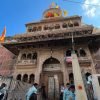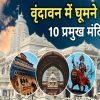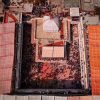The very charming ‘Shahji Temple’ made of white marble near ‘Nidhivan’ in the temple city of Vrindavan is a wonderful example of its architecture, painting and sculpture. This temple is famous in Braj as ‘Tede Khamba Temple’. All the 12 pillars of this temple, which are 15 feet long, are serpentine and are made from a single stone, which are unique examples of architecture.

The story of the construction of this temple is interesting. Seth Kundan Lal Shah of Lucknow was a devotee of Chaitanya Mahaprabhu and had close relations with Nawab Wajid Ali Shah. In 1858, the Nawab Sahib was arrested by the British government. After the arrest of the Nawab, Kundan Lal Shah came and settled in Vrindavan, he laid the foundation of this temple in 1860. Eight years later, in 1868, on the day of Basant Panchami, this magnificent temple was completed. The idol of Thakur Shriradharman Lal Ji is seated on a golden throne in the temple.


The main gate of the temple is designed on the Roman church, on which two fishes are depicted and on the parapet of the temple, dancers are shown singing, playing and dancing. A peacock is catching the drops of water falling from the dancer’s hair, which is a unique example of Shringar Rasa. F.S. Grous has written in his book ‘Mathura: A District Memoir’ that the type of painting that is in Shahji’s temple is the same as that in a casino in London. It is said that for the construction of this temple, chandeliers and glass items were ordered from Iran and Belgium and then the rooms of the temple were decorated.

Two influences are visible on the ‘Shahji Mandir’, first Nawabi and second foreign art. Along with the statues of Sakhis installed in the temple square, there is also a statue of Nawab Wajid Ali Shah in the guise of a Sakhi wearing a cap, which seems to tell the story of the intimate relationship between Nawab Saheb and the builder of the temple, Shahji. The main attraction of this temple is the Basanti room, which opens for devotees only twice a year. Two days on Basant Panchami and on Trayodashi and Chaturdashi in the month of Shravan.

































